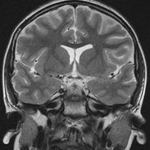Main Article Content
Abstract
Background: Valproate (VPA) has been previously described to cause reversible cerebral atrophy and cognitive decline, but few cases are reported and neuropsychological data is lacking. We report a case of VPA induced encephalopathy in an 11-year-old girl with temporal lobe epilepsy, presenting with impaired cognition and sedation combined with cerebral atrophy.
Methods: Cognitive capacity was assessed using Wechsler Intelligence Scales for Children IV (WISC), non-standardised word lists and visual reproduction. Brain magnetic resonance imaging (MRI) was performed prior to, during and post VPA therapy.
Results: Our patient demonstrated average full-scale intelligence quotient, verbal comprehension, perceptual reasoning and working memory. There was a marked discrepancy in processing speed, which ranked low average (score – 80; 9th percentile). Difficulties with mental abstraction and manipulation were noted. Brain MRI (3T) demonstrated mild generalised parenchymal atrophy. Cessation of VPA resulted in dramatic improvement in clinical symptoms (1 month after cessation) and normalisation of brain MRI (11 months after cessation). Progress neuropsychological testing 13 months after cessation showed marked improvements in processing speed.
Conclusion: This case provides an important reminder of this rare but importantly reversible syndrome with new information supporting the neuropsychological changes involved.
Article Details
Copyright (c) 2019 Emily Amy Innes, Alexandra M Johnson

This work is licensed under a Creative Commons Attribution-NonCommercial-ShareAlike 4.0 International License.
Authors who publish with this journal agree to the following terms:
Authors retain copyright and grant the journal right of first publication with the work simultaneously licensed under a Creative Commons Attribution License that allows others to share the work with an acknowledgement of the work's authorship and initial publication in this journal.
Authors are able to enter into separate, additional contractual arrangements for the non-exclusive distribution of the journal's published version of the work (e.g., post it to an institutional repository or publish it in a book), with an acknowledgement of its initial publication in this journal.
Authors are permitted and encouraged to post their work online (e.g., in institutional repositories or on their website) prior to and during the submission process, as it can lead to productive exchanges, as well as earlier and greater citation of published work (See The Effect of Open Access).

